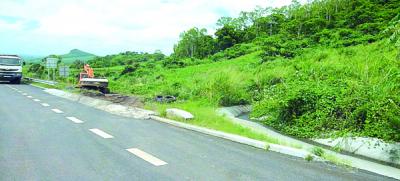So much had been said and seen on the Terre Rouge – Verdun Road collapse! and collapse it is.
I’ll restrain this article to four sections, namely:
(I) What you already know,
(II) What you may know and
(III) What you have observed and
(IV) What you would like to know
What you already know
A road (pavement) structure is a levelled surface which transmits its own (static load) and any imposed (traffic) load to the underlying bearing strata made of a crushed stone base layer and a sub-grade layer beneath the crushed stones, all sitting on a road bed. If the road bed is weak (for example organic or clayey soil), it is simply removed to a certain depth depending on the type of road being constructed (a side access or a motorway) and replaced by a high quality material such as field stones (commonly called “grabo”) or sandy soil.
A good sub-grade material should not be too clayey and should have a high strength or bearing capacity, measured respectively by a low plasticity index (PI) and a high California Bearing Ratio (CBR).
Clay (cohesive) soil, unlike sandy soil, exerts a high internal pressure known as pore pressure, because the water within its particles cannot easily get expelled (because of its poor permeability) and this is made worse by insufficient drainage conditions (Darcy Law in Engineering jargon).
Any static load or imposed load transmitted to a clay medium beneath an asphalt surfacing causes the clay stratum to deform and to act as a plastic material flowing down a slope or as a mattress on levelled ground. This happens because the water within the stratum cannot get expelled easily for the load to be borne by the soil particles themselves.
For this reason clay material underneath a proposed road is replaced by material of a higher strength, either by field stones as was done in the La Nicolière (mountainous) road constructed some 100 years ago or by granular (non cohesive) soil as is currently the practice nowadays for major roads. Out of economic reasons the road profile is designed in such a way that the amount of soil cut from one location is used as sub-grade fill in another location, PROVIDED IT IS OF GOOD QUALITY (Low PI and high CBR value).
The CBR test is in essence a simple test to measure the force needed for a rod to penetrate a selected fill material compared to the force needed to penetrate an equal distance into a crushed stone material. The stronger the soil, the higher is its CBR.
What you may know
Depending on the nature of the original ground (granular or clayey), the sub-grade layer used to replace the existing ground material may vary between 50 cm to 2.0 metres. Below this depth the pavement loads are spread well enough so as not to appreciably affect the road bed.
The problem arises when due to improper soil investigation, faulty design, a contractor’s attempt to cut cost or improper construction supervision by the Consultant and his Works Inspectors, this clayey layer is either left un-replaced or is replaced by a readily available fill material of equally poor quality coming from a cut operation.
On levelled roads, the deformation of poor sub-grade material manifests itself as lizard cracks (rutting or “nid de poule”) on the road surface as was extensively experienced on the La Vigie – Nouvelle France road, barely a year after its construction.
On sloping roads, the plastic deformation of the clayey sub-grade layer (known as “creep” in engineering terms and having the same meaning in common language) is accompanied by spectacular cracks and crevasses caused by the road surface “slipping” downhill (Imagine a drop of thick syrup on a sloping piece of cardboard).
What you have observed
At the location where the crevasses had developed, the road rests partly on a cut section of a mountain slope and partly on an earth embankment of approximate height 6 m. Whilst the mountain slope dips across the road, the road itself slopes down toward the north.
Had the weakness been deep-seated into the ground, a landslide would have occurred, entraining in its wake a whole chunk of the road down the hill slope away from the road alignment. This was not the case, as the crevasses had developed mostly across the road.
What you would like to know
The devil seems to lie within the superficial sub-grade fill material beneath the crushed stone base. The specification for this load bearing material is usually very stringent with granular soil of plasticity index below 20 and a high CBR value of 10 or more, compacted in layers to a given standard. Had this been clearly specified? And if yes, had the specification been strictly adhered to? This is where the Authorities have to concentrate their investigative efforts and this should not be limited to the collapsed sections, but at levelled surfaces as well because rutting is as serious a structural failure as a creep failure, although not as spectacular.
Re-building on piles is almost a myth and is a very expensive solution (Dream Highway!).
Whilst tests are ongoing and blames are being dispensed and shifted, the Authorities should get at least one lane rehabilitated, without prejudice to their rights.
They should start with the south bound slow lane (the lane closest to the mountain) by replacing the existing V-drain with a deep surface cum buried (French) drain, renewing the sub-grade fill to a depth of at least 2 meters below the original ground profile, overlaid with the normal crushed stone base course and the asphaltic surfacing.
TERRE-ROUGE – VERDUN MOTORWAY : The devil may just be beneath the surface
- Publicité -
EN CONTINU ↻


